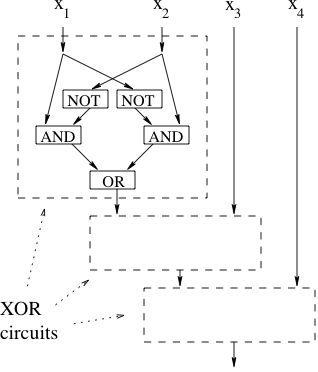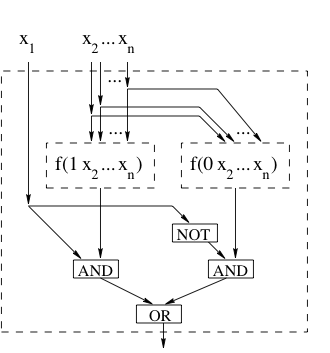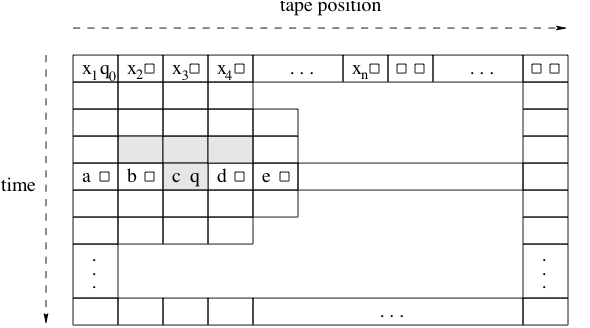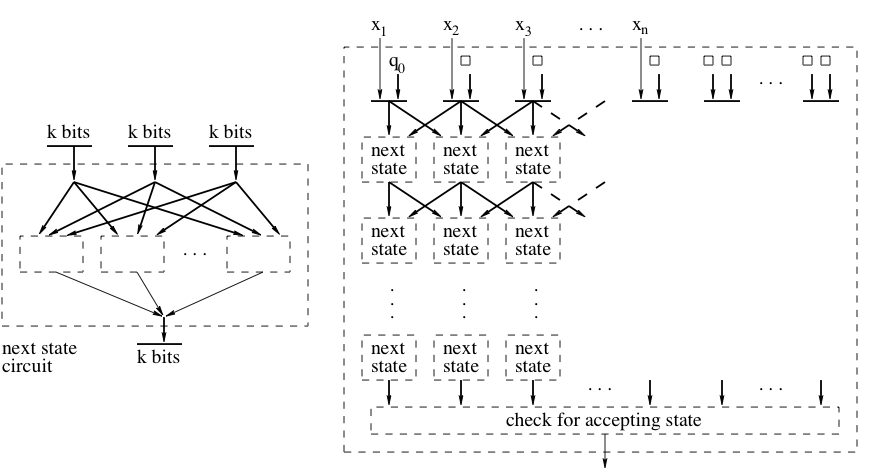In this lecture we introduce the computational model of boolean circuits and prove that polynomial size circuits can simulate all polynomial time computations. We also begin to talk about randomized algorithms.
1. Circuits
A circuit has
inputs,
outputs, and is constructed with AND gates, OR gates and NOT gates. Each gate has in-degree 2 except the NOT gate which has in-degree 1. The out-degree can be any number. A circuit must have no cycle. The following picture shows an example of a boolean circuit computing the function

Define of AND and OR gates of
. By convention, we do not count the NOT gates.
To be compatible with other complexity classes, we need to extend the model to arbitrary input sizes:
Definition 1 A language
is solved by a family of circuits
if for every
and for every
s.t.
,
Definition 2 Say
if
is solved by a family
of circuits, where
has at most
gates.
2. Relation to other complexity classes
Unlike other complexity measures, like time and space, for which there are languages of arbitrarily high complexity, the size complexity of a problem is always at most exponential.
Proof: We need to show that for every 1-output function ,
has circuit size
.
Use the identity to recursively construct a circuit for
, as shown in the figure below

The recurrence relation for the size of the circuit is: with base case
, which solves to
.
The exponential bound is nearly tight.
Theorem 4 There are languages
such that
. In particular, for every
, there exists
that cannot be computed by a circuit of size
.
Proof: This is a counting argument. There are functions
, and we claim that the number of circuits of size
is at most
, assuming
. To bound the number of circuits of size
we create a compact binary encoding of such circuits. Identify gates with numbers
. For each gate, specify where the two inputs are coming from, whether they are complemented, and the type of gate. The total number of bits required to represent the circuit is
So the number of circuits of size is at most
, and this is not sufficient to compute all possible functions if
This is satisfied if and
.
The following result shows that efficient computations can be simulated by small circuits.
Theorem 5 If
, then
.
Proof: Let be a decision problem solved by a machine
in time
. Fix
and
s.t.
, and consider the
tableau of the computation of
. See the figure below.

Assume that each entry of the tableau is encoded using
bits. By Proposition 3, the transition function
used by the machine can be implemented by a “next state circuit” of size
, which is exponential in
but constant in
. This building block can be used to create a circuit of size
that computes the complete tableau, thus also computes the answer to the decision problem. The complete construction is shown in the figure below.

Corollary 6
.
On the other hand, it’s easy to show that , and, in fact, one can define languages in
that are undecidable.
3. Randomized Algorithms
First we are going to describe the probabilistic model of computation. In this model an algorithm gets as input a sequence of random bits
and the ”real” input
of the problem. The output of the algorithm is the correct answer for the input
with some probability.
Definition 7 An algorithm
is called a polynomial time probabilistic algorithm if the size of the random sequence
is polynomial in the input
and
runs in time polynomial in
.
If we want to talk about the correctness of the algorithm, then informally we could say that for every input we need
. That is, for every input the probability distribution over all the random sequences must be some constant bounded away from
. Let us now define the class BPP.
Definition 8 A decision problem
is in
if there is a polynomial time algorithm
and a polynomial
such that :
We can see that in this setting we have an algorithm with two inputs and some constraints on the probabilities of the outcome. In the same way we can also define the class P as:
Definition 9 A decision problem
is in
if there is a polynomial time algorithm
and a polynomial
such that :
Similarly, we define the classes and ZPP.
Definition 10 A decision problem
is in
if there is a polynomial time algorithm
and a polynomial
such that:
Definition 11 A decision problem
is in
if there is a polynomial time algorithm
whose output can be
and a polynomial
such that :
4. Relations between complexity classes
After defining these probabilistic complexity classes, let us see how they are related to other complexity classes and with each other.
Theorem 12 RP
NP.
Proof: Suppose we have a algorithm for a language
. Then this algorithm is can be seen as a “verifier” showing that
is in NP. If
then there is a random sequence
, for which the algorithm answers yes, and we think of such sequences
as witnesses that
. If
then there is no witness.
We can also show that the class ZPP is no larger than RP.
Theorem 13 ZPP
RP.
Proof: We are going to convert a ZPP algorithm into an RP algorithm. The construction consists of running the ZPP algorithm and anytime it outputs , the new algorithm will answer
. In this way, if the right answer is
, then the algorithm will answer
with probability
. On the other hand, when the right answer is
, then the algorithm will give the wrong answer with probability less than
, since the probability of the ZPP algorithm giving the output
is less than
.
Another interesting property of the class ZPP is that it’s equivalent to the class of languages for which there is an average polynomial time algorithm that always gives the right answer. More formally,
Theorem 14 A language
is in the class
if and only if
has an average polynomial time algorithm that always gives the right answer.
Proof: First let us clarify what we mean by average time. For each input we take the average time of
over all random sequences
. Then for size
we take the worst time over all possible inputs
of size
. In order to construct an algorithm that always gives the right answer we run the
algorithm and if it outputs a
, then we run it again. Suppose that the running time of the
algorithm is
, then the average running time of the new algorithm is:
Now, we want to prove that if the language has an algorithm that runs in polynomial average time
, then this is in ZPP. We run the algorithm for time
and output a
if the algorithm has not yet stopped. It is straightforward to see that this belongs to ZPP. First of all, the worst running time is polynomial, actually
. Moreover, the probability that our algorithm outputs a
is less than
, since the original algorithm has an average running time
and so it must stop before time
at least half of the times.
Let us now prove the fact that is contained in BPP.
Theorem 15 RP
BPP
Proof: We will convert an algorithm into a
algorithm. In the case that the input
does not belong to the language then the
algorithm always gives the right answer, so it certainly satisfies that
requirement of giving the right answer with probability at least
. In the case that the input
does belong to the language then we need to improve the probability of a correct answer from at least
to at least
.
Let be an RP algorithm for a decision problem
. We fix some number
and define the following algorithm:
- input:
,
- pick
- if
then return 0
- else return 1
Let us now consider the correctness of the algorithm. In case the correct answer is the output is always right. In the case where the right answer is
the output is right except when all
.
It is easy to see that by choosing an appropriate the second probability can go arbitrarily close to
. In particular, choosing
suffices to have a probability larger than
, which is what is required by the definition of BPP. In fact, by choosing
to be a polynomial in
, we can make the probability exponentially close to
. This means that the definition of
that we gave above would have been equivalent to a definition in which, instead of the bound of
for the probability of a correct answer when the input is in the language
, we had have a bound of
, for a fixed polynomial
.
Let, now, A be a BPP algorithm for a decision problem . Then, we fix
and define the following algorithm:
- input:
- pick
-
- if
then return 1
- else return 0
In a BPP algorithm we expect the right answer to come up with probability more than . So, by running the algorithm many times we make sure that this slightly bigger than
probability will actually show up in the results.
We will prove next time that the error probability of algorithm is at most
.
